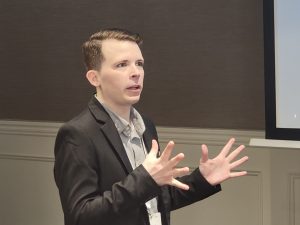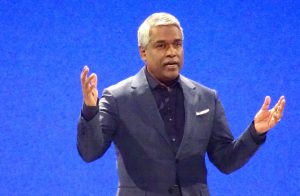Navigating Enterprise towards Big Data; Effective Data Strategy
![]() The importance of embracing business analytics to make better business decisions cannot be understated. One of the obstacles for adoption of Big Data in the enterprise is an understanding of how to leverage a company’s data more efficiently and effectively. Organizations that embrace this technology will have the opportunity to exceed where their peers cannot. That is the dynamic ability to analyze data closer and closer to real time and do so with specific relevance marks a significant change from the classic business paradigm of data analysis and decision making.
The importance of embracing business analytics to make better business decisions cannot be understated. One of the obstacles for adoption of Big Data in the enterprise is an understanding of how to leverage a company’s data more efficiently and effectively. Organizations that embrace this technology will have the opportunity to exceed where their peers cannot. That is the dynamic ability to analyze data closer and closer to real time and do so with specific relevance marks a significant change from the classic business paradigm of data analysis and decision making.
In a just released report on Big Datafrom the McKinsey Global Institute, the analysis of transformative potential in the enterprise provides some insight on how the industry is shifting towards the value of Big Data.
“The effective use of big data has the potential to transform economies, delivering a new wave of productivity growth and consumer surplus. Using big data will become a key basis of competition for existing companies, and will create new competitors who are able to attract employees that have the critical skills for a big data world. Leaders of organizations need to recognize the potential opportunity as well as the strategic threats that big data represent and should assess and then close any gap between their current IT capabilities and their data strategy and what is necessary to capture big data opportunities relevant to their enterprise.”
The report further goes into specifics:
“Drawing on detailed analysis of five domains—health care, retailing, the public sector, manufacturing, and personal location data—the research identifies five broadly applicable ways to leverage big data:
• Making big data more accessible in a timely manner. In the public sector, making data more accessible across otherwise separated departments can sharply reduce search and processing time. In manufacturing, integrating data from R&D, engineering, and manufacturing units to enable concurrent engineering can cut time-to-market.
• Using data and experimentation to expose variability and improve performance. As they create and store more transactional data in digital form, organizations can collect more accurate and detailed performance data on everything from product inventories to personnel sick days.
• Segmenting populations to customize actions. Big data allow organizations to create ever-narrower segmentations and to tailor services precisely to meet customer needs. This approach is well-known in marketing and risk management, but can be revolutionary in places like the public sector.
• Replacing and supporting human decision-making with automated algorithms. Sophisticated analytics can substantially improve decision making, minimize risks, and unearth valuable insights that would otherwise remain hidden. Such analytics have applications from tax agencies to retailers.
• Innovating new business models, products, and services. Manufacturers are using data obtained from the use of products to improve the development of the next generation of products, and to create innovative after-sales service offerings. The emergence of real-time location data has created a new set of location-based mobile services from navigation to people tracking.“
![]() This analysis all touches back on an overlying point; that most companies haven’t produced much thought at this point into how to gain advantageous insight from increasingly massive data they are collecting. It is pretty clear that this will change and do so very soon. Companies will soon encounter the need to access and analyze their own data, but data from third parties as well, integrating these sets to gain information that is predictive, accurate, and up to the minute.
This analysis all touches back on an overlying point; that most companies haven’t produced much thought at this point into how to gain advantageous insight from increasingly massive data they are collecting. It is pretty clear that this will change and do so very soon. Companies will soon encounter the need to access and analyze their own data, but data from third parties as well, integrating these sets to gain information that is predictive, accurate, and up to the minute.
So how can thought leaders in the enterprise embrace this and progress towards the Big Data movement? An effective data strategy for any organization begins with the identification and consistent availability of targeted data. Analytic value has to be identified from this available data. The impact of information gained should be the single most significant evaluation in gauging the value.
Another major component on the big data mission is possession of or building an action team across the enterprise that is comprised of leadership and contributors to the big analytic picture. Vision at all levels can be critical to success. That vision should include a perspective on the customer and that often means a rich understanding of what the customer needs, wants or is doing.
Technology provides a critical component across all of these and within the strategy. The technology is continually evolving and changing the way leaders are doing business. An organization that draws on all of these can be assured of continued success in the Big Data endeavor. It’s the same old technology story in the enterprise, new technology needs a champion to affect strategic adoption in the organizations. The organizations that embrace that technology first and most efficiently stand to gain from the fruits that are produced.
On that point, a deep read of the very long and informative McKinsey Report has a wealth of interesting information in it and should be reviewed by anyone interested in the state of big data analytics. In coming analysis, expect more alignment with the evolving big data paradigm and the technology that is driving it.
A message from John Furrier, co-founder of SiliconANGLE:
Your vote of support is important to us and it helps us keep the content FREE.
One click below supports our mission to provide free, deep, and relevant content.
Join our community on YouTube
Join the community that includes more than 15,000 #CubeAlumni experts, including Amazon.com CEO Andy Jassy, Dell Technologies founder and CEO Michael Dell, Intel CEO Pat Gelsinger, and many more luminaries and experts.
THANK YOU












